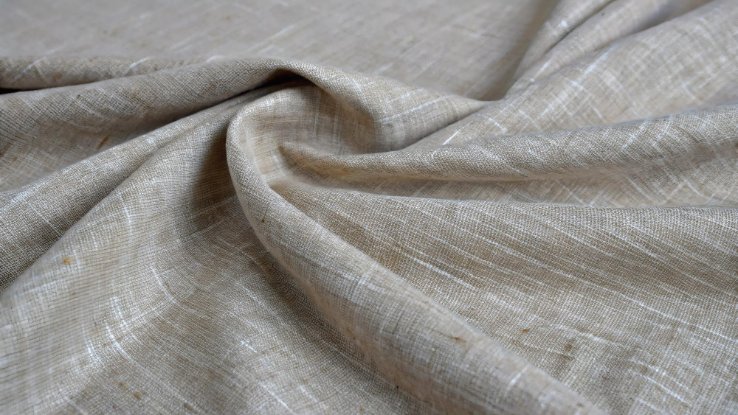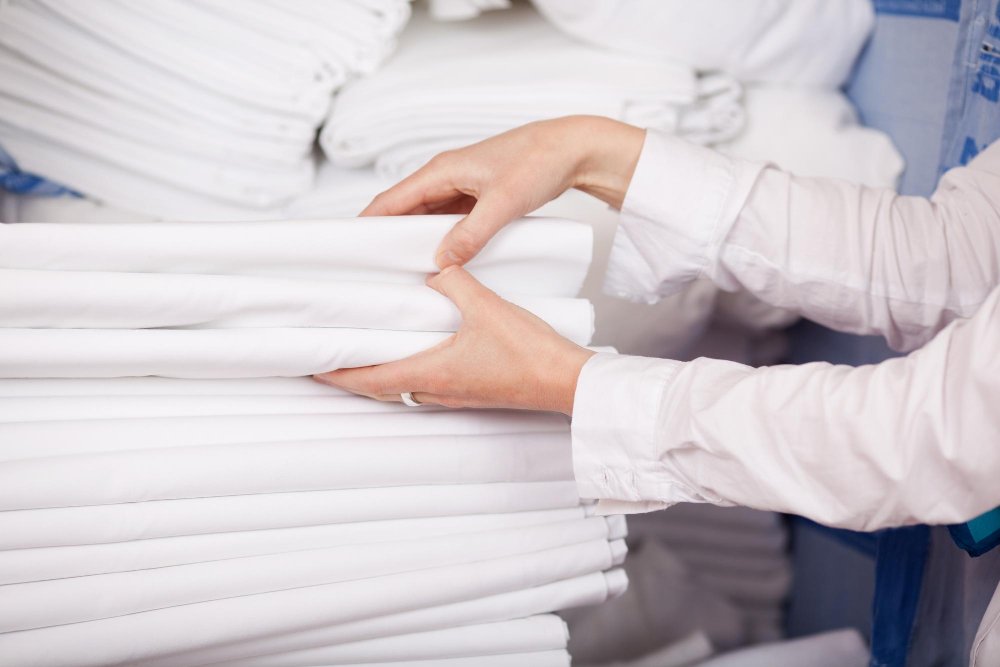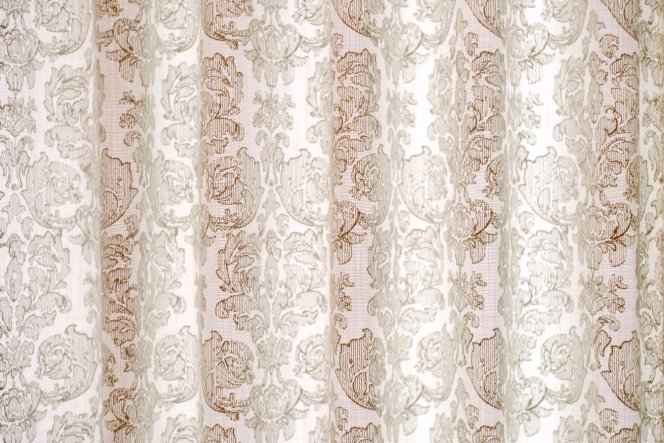Understanding the beauty and versatility of yarn-dyed linen for modern homes
Table of Contents
- What Is Mélange Weave Linen?
- How Linen Is Made: From Flax to Fabric
- What Makes Mélange Weave Different
- Comparison with Other Linen Types
- Characteristics and Properties
- Mélange vs Jersey, Heather, and Cotton
- Summer or Winter? Seasonal Versatility
- Applications in Home Design
- Care and Maintenance
- Sustainability Considerations
- Frequently Asked Questions
What Is Mélange Weave Linen?
Mélange weave linen is a type of linen fabric created by weaving together yarns in different complementary colors. The word “mélange” comes from French, meaning “mixture” or “blend.” In textile terms, it describes how different colored threads combine in the warp (lengthwise) and weft (crosswise) directions to create visual depth and subtle color variations throughout the fabric.
The Key Difference
Unlike solid-dyed linen that’s colored after weaving, or printed linen where patterns are applied to the surface, mélange weave gets its character from yarn-dyeing before weaving. Each thread is dyed individually, then woven into the fabric. This means the colors are built into the structure itself, not just sitting on top.
Think of it like a checkerboard where the squares aren’t perfectly uniform. When you stand back, you see a cohesive color with interesting depth. Up close, you notice the interplay of different tones. This gives mélange linen a more organic, less manufactured appearance compared to solid colors.
What Does “Mélange” Mean in English?
In English, “mélange” (borrowed directly from French) means a mixture or medley of different elements. You’ll hear it used for coffee blends, musical compilations, or any combination of varied components. In fabric terms, it specifically refers to the mixing of colored yarns during the weaving process.
What About French Slang?
In everyday French, “mélange” simply means “mix” or “mixture.” There’s no special slang meaning beyond the standard definition. However, if you’re a fan of the Dune science fiction series, you might know “mélange” as the precious spice central to the story. That’s a fictional use, though the name was chosen because of the word’s meaning of “valuable mixture.”
Want to explore other linen varieties? Check out our guides on plain weave linen and damask linen to see how they compare.
How Linen Is Made: From Flax to Fabric
Before we get into what makes mélange weave special, it helps to understand how all linen fabric begins. Linen comes from the flax plant (Linum usitatissimum), one of humanity’s oldest cultivated crops. Archaeological evidence shows people were using flax fibers over 30,000 years ago. Ancient Egyptians wrapped mummies in linen bandages and wove fabric so fine it had 540 threads per inch (finer than most modern textiles).
The Production Journey
-
Growing and Harvesting
Flax plants take about 100 days from planting to harvest. They grow to 3-4 feet tall with blue-purple flowers. When the stems turn yellow and seeds brown, the flax is ready. Here’s the interesting part: the best linen comes from plants that are pulled up by the roots (not cut) because this preserves the longest fibers and prevents sap from leaking out and drying the fibers. -
Retting
This process separates the usable fibers from the woody stalk. Farmers spread the harvested flax across fields where dew and natural bacteria break down the plant material (dew-retting), or submerge it in water streams (water-retting). This step is critical because it determines the fiber quality. Over-retting creates weak, mushy fibers, while under-retting makes it hard to remove the woody bits later. -
Scutching
After the stalks are fully dried, they go through scutching, where machines (or traditionally, wooden tools) break and remove the straw material surrounding the fibers. This is labor-intensive but necessary to reveal the silky linen strands inside. -
Combing (Hackling)
The fibers are pulled through coarse combs to remove any remaining plant material and align all the strands in the same direction. This creates smooth, parallel fibers ready for spinning. -
Spinning
The prepared flax fibers are spun into yarn. Linen yarn is less elastic than cotton, which is why it can be tricky to work with but creates such strong fabric. -
Dyeing (For Mélange)
Here’s where mélange weave differs from other methods. The yarns are dyed at this stage, before weaving. Different colors are applied to different yarn batches. Some yarns might stay natural, while others are dyed navy, gray, or other shades. -
Weaving
Finally, the dyed yarns are woven together on a loom. For mélange fabric, the weaver alternates different colored yarns in both the warp and weft directions, creating that characteristic mixed appearance.
Geographic Quality Indicators
Belgium is widely considered to produce the world’s finest flax fibers, with Irish and Scottish linen close behind. The Baltic region, particularly Lithuania, is known for exceptional quality linen that softens beautifully with use. France (especially Normandy) produces about 75% of the world’s flax, with the European Union growing 70% of all flax globally. Egyptian linen from the Nile River valley is prized for its long, fine fibers.
The quality comes down to climate (cool, damp weather is ideal for flax), soil conditions, and centuries of specialized knowledge passed down through generations. European flax requires no irrigation, no GMOs, and minimal pesticides due to the ideal growing conditions.
You can learn more about caring for linen properly in our linen care guide.
What Makes Mélange Weave Different
Now that you know how linen is made, let’s look at what sets mélange apart from other weaving techniques.
The Weaving Technique
Mélange weave uses a cross-weave or yarn-dyed technique. Remember when we talked about warp and weft threads? The warp threads run lengthwise on the loom, held under tension. The weft threads are woven over and under the warp threads horizontally.
In mélange fabric, one color is used for the warp and a different (but complementary) color for the weft. For example:
- Navy warp threads + off-white weft threads = a blue-gray appearance
- Charcoal warp threads + natural weft threads = a warm gray with depth
- Natural warp threads + dusty blue weft threads = a soft, muted blue
When light hits the fabric from different angles, you see different dominant colors. This creates a changeable, almost iridescent quality that solid fabrics can’t match.
Visual Characteristics
Mélange linen has a grainy, chambray-like appearance. The color isn’t uniform across the surface. Instead, you see tiny dots or specks of the different thread colors. This creates:
- Depth: The fabric doesn’t look flat; it has dimensional quality
- Subtle texture: Even though the weave might be plain, the color mixing adds visual interest
- Sophisticated neutrality: Mélange tones tend to be muted and easy to work with in design
- Reduced wrinkling visibility: The color variation helps disguise creases that might be obvious in solid colors
This technique is similar to how chambray cotton is woven, though chambray typically uses white weft with colored warp specifically.
Comparison with Other Linen Types
Linen comes in many varieties, each with distinct characteristics. Here’s how mélange compares to other common types:
| Linen Type | Weave Characteristic | Visual Effect | Best For |
|---|---|---|---|
| Mélange Weave | Yarn-dyed, mixed colors in warp and weft | Subtle depth, grainy texture, non-uniform color | Modern interiors, decorative pieces, bedding |
| Plain Weave | Simple over-under pattern | Uniform color, smooth surface | Everyday bedding, curtains, lightweight garments |
| Damask | Jacquard loom with ornate patterns | Reversible designs, lustrous finish | Formal table linens, elegant home decor |
| Loose Weave | Open structure, widely spaced threads | Transparent appearance, high breathability | Lightweight curtains, summer scarves, towels |
| Sheeting Linen | Heavy, densely woven | Crisp, substantial feel | Bed sheets, structured garments, upholstery |
| Huckaback | Unique honeycomb texture | 3D raised pattern, absorbent | Towels, dish cloths, kitchen textiles |
Each type serves different needs. Mélange sits in the middle ground between decorative (like damask) and purely functional (like plain weave or toweling linen). It gives you visual interest without bold patterns.
Use our interactive linen type selector to find which variety best matches your project needs.
Characteristics and Properties
Mélange linen shares the core benefits of all linen fabrics, with some unique qualities from its yarn-dyed construction.
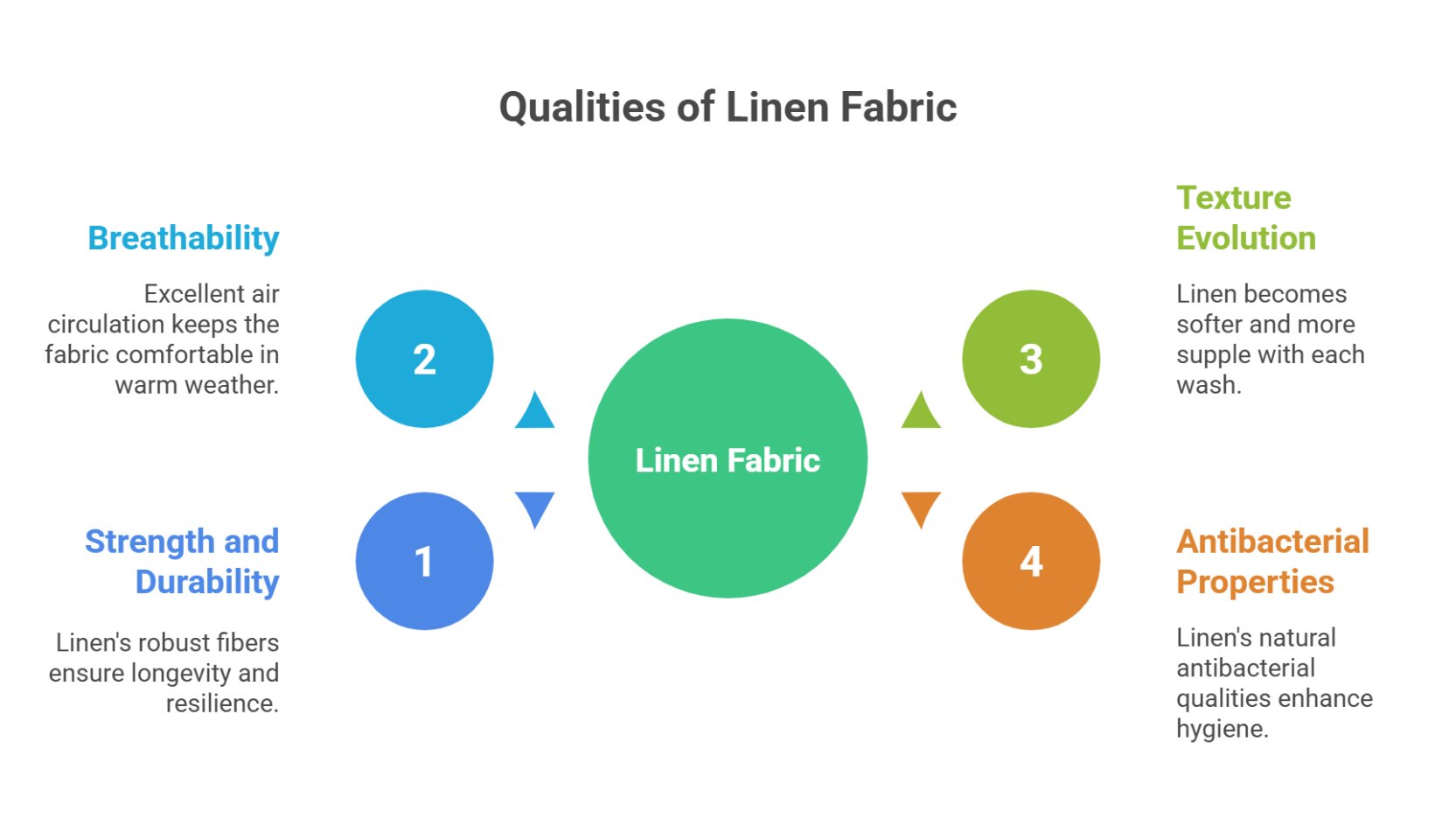
Strength and Durability
Flax fibers are two to three times stronger than cotton fibers. Your mélange linen pieces can last for decades with proper care. The fabric won’t pill or thin out even after years of washing. Bedding maintains crisp edges and smooth surfaces.
Breathability
Microscopic gaps between the fibers allow continuous airflow. This prevents overheating in summer and naturally retains warmth in winter. The fabric wicks moisture away from your skin, keeping you comfortable year-round.
Texture Evolution
New linen feels crisp and slightly stiff. After 3-5 washes, it develops a softer, more supple feel. This isn’t damage; it’s the fibers relaxing and becoming more flexible. Your linen gets better with age, developing a personalized handfeel that improves over time.
Antibacterial Properties
Linen naturally resists odors and bacteria. This means you can wash bedding less frequently without it getting musty. For people with allergies or sensitive skin, this helps minimize nighttime irritants.
Understanding Fabric Weight
Mélange linen typically falls in the medium-weight category. Here’s how linen weights compare:
Linen Weight Classifications
- Lightweight (under 150 g/m²): Perfect for summer garments, scarves, and delicate projects. Drapes beautifully but may be too sheer for some uses.
- Medium weight (150-200 g/m²): The sweet spot for bedding, light upholstery, and home decor. Substantial enough for structure while remaining breathable. Most mélange weave falls here.
- Heavyweight (over 200 g/m²): Ideal for heavy upholstery, canvas applications, and structured items that need to hold their shape.
A typical mélange linen at 160 g/m² strikes the right balance. It’s heavy enough to feel quality and drape nicely, but light enough to remain comfortable and breathable. You can calculate fabric requirements for your projects using our linen fabric weight calculator.
Shrinkage and Sizing
Linen naturally shrinks 5-8% after the first wash. This is normal and expected. Many manufacturers account for this by weaving fabric slightly wider than the final dimensions. For example, fabric might measure 255 cm wide unwashed but settle at 235-240 cm after washing.
This is why you should always pre-wash linen before sewing projects. If you’re buying for curtains or upholstery, order a bit extra to account for shrinkage.
Mélange vs Jersey, Heather, and Cotton
People often confuse mélange with other fabric terms. Let’s clear up the differences.
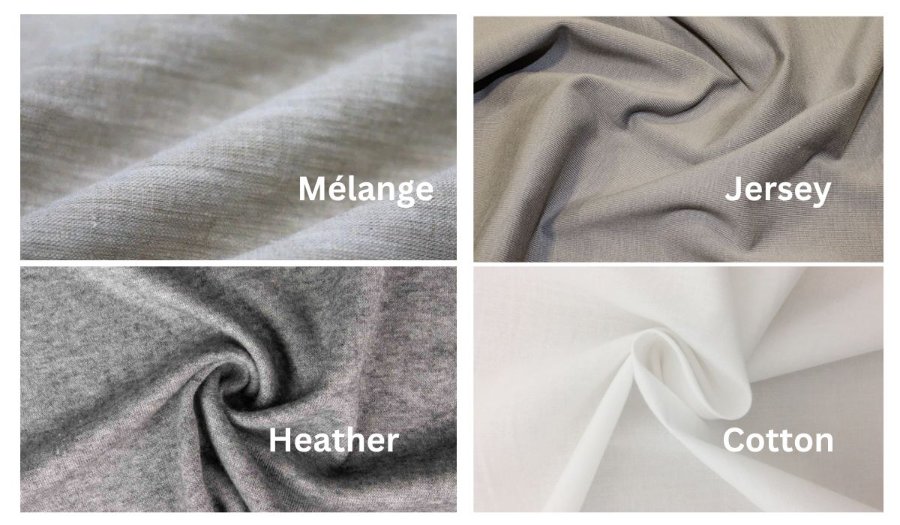
Is Mélange Fabric the Same as Jersey?
No. Jersey refers to a knit fabric construction (think t-shirts), while mélange describes a color technique. You can have mélange jersey (knit fabric with mixed colors) or mélange woven fabric (like our linen). Jersey is stretchy because it’s knit in loops. Mélange linen is woven in a stable crisscross pattern with no stretch.
The confusion comes from seeing “mélange jersey” as a common fabric description in clothing. That’s describing knit fabric with yarn-dyed mixed colors, different from woven mélange linen.
What’s the Difference Between Heather and Mélange?
Both create a mixed color effect, but they use different methods:
- Heather: Created by blending different colored fibers together before spinning into yarn. If you look closely at a heather gray shirt, you’ll see tiny flecks of black and white fibers mixed randomly throughout. The mixing happens at the fiber stage.
- Mélange: Created by weaving different colored yarns together. Each thread is a solid color, but the weaving pattern creates the mixed appearance. The mixing happens at the weaving stage.
Heather typically has a more random, speckled look. Mélange has a more structured, grain-like appearance because of the organized warp and weft pattern.
Can Mélange Be 100% Cotton?
Absolutely. “Mélange” describes the coloring technique, not the fiber content. You can find mélange cotton, mélange linen, mélange wool, or even mélange synthetic fabrics. The technique works with any yarn that can be dyed and woven.
Cotton mélange is common in casual clothing and home textiles. The process is the same: dye different batches of yarn in complementary colors, then weave them together. Cotton mélange tends to be softer and more affordable than linen, but won’t have the same durability or crisp texture.
What Color Are Mélange Clothes?
Mélange fabrics come in many color combinations, but they share a muted, sophisticated quality. Common options include:
- Gray mélange: Charcoal and light gray, or black and white combinations
- Blue mélange: Navy with off-white, or various blue tones mixed together
- Natural mélange: Undyed linen with darker natural shades
- Green mélange: Olive or sage tones mixed with beige or cream
- Brown mélange: Various earth tones woven together
The colors tend to be “dusty” or “vintage” looking rather than bright and saturated. This makes mélange pieces easy to incorporate into existing decor schemes. They add interest without overwhelming a space.
What Is Modern Mélange Fabric?
“Modern mélange” usually refers to contemporary color combinations and updated production methods. While the basic yarn-dyeing technique hasn’t changed, modern versions might use:
- On-trend color palettes (like current fashion season colors)
- More precise dye formulations for consistent results
- Eco-friendly dyeing processes
- Novel fiber combinations (mixing linen with satin or other materials)
It’s more of a marketing term than a technical distinction. The core concept remains the same as traditional mélange.
Summer or Winter? Seasonal Versatility
Is mélange fabric better for summer or winter? The answer is both. This is one of linen’s standout qualities.
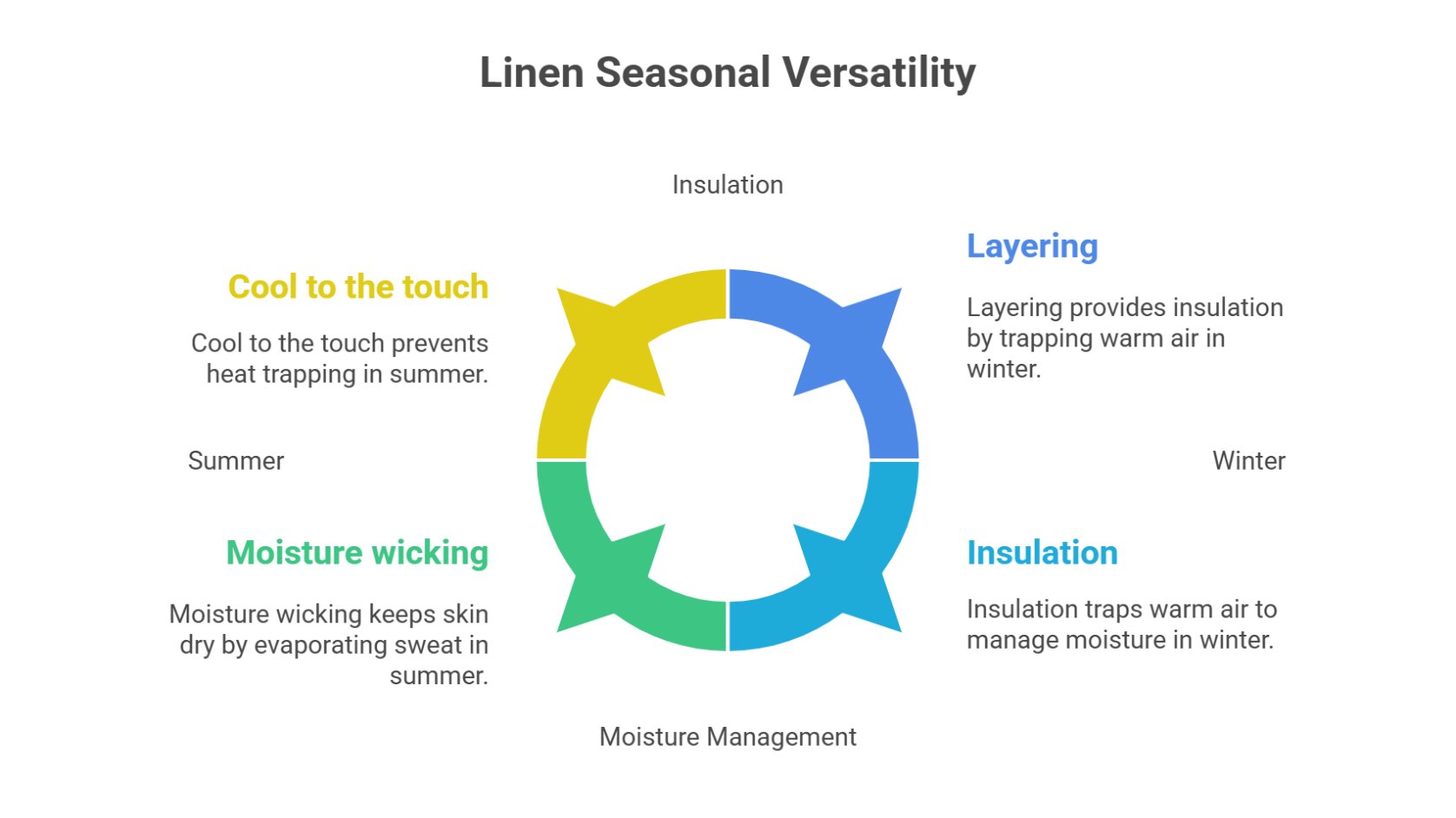
Why Linen Works Year-Round
Linen is naturally thermoregulating. The same fabric that keeps you cool in July will help retain warmth in January. Here’s how:
Summer Benefits
- Moisture wicking: Linen can absorb up to 20% of its weight in moisture before feeling damp. It pulls sweat away from your skin and allows it to evaporate quickly.
- Airflow: The fiber structure allows air to circulate continuously, preventing that sticky, trapped feeling you get with some fabrics.
- Cool to the touch: Linen doesn’t trap heat against your body like synthetic materials do.
Winter Benefits
- Insulation: The same structure that allows airflow also traps tiny pockets of warm air next to your body.
- Moisture management: In winter, linen keeps you dry by wicking away the moisture that would make you feel cold and clammy.
- Layering: Linen works beautifully as a base layer or top sheet because it breathes while adding warmth.
The mélange coloring doesn’t change these properties. However, darker mélange colors (like navy or charcoal combinations) might feel more appropriate for winter decor, while lighter natural tones feel summery. But functionally, the fabric works equally well in any season.
Check out our summer fabrics guide and winter fabrics guide to learn about seasonal fabric choices.
Applications in Home Design
Mélange linen’s sophisticated appearance and practical properties make it perfect for many home uses.
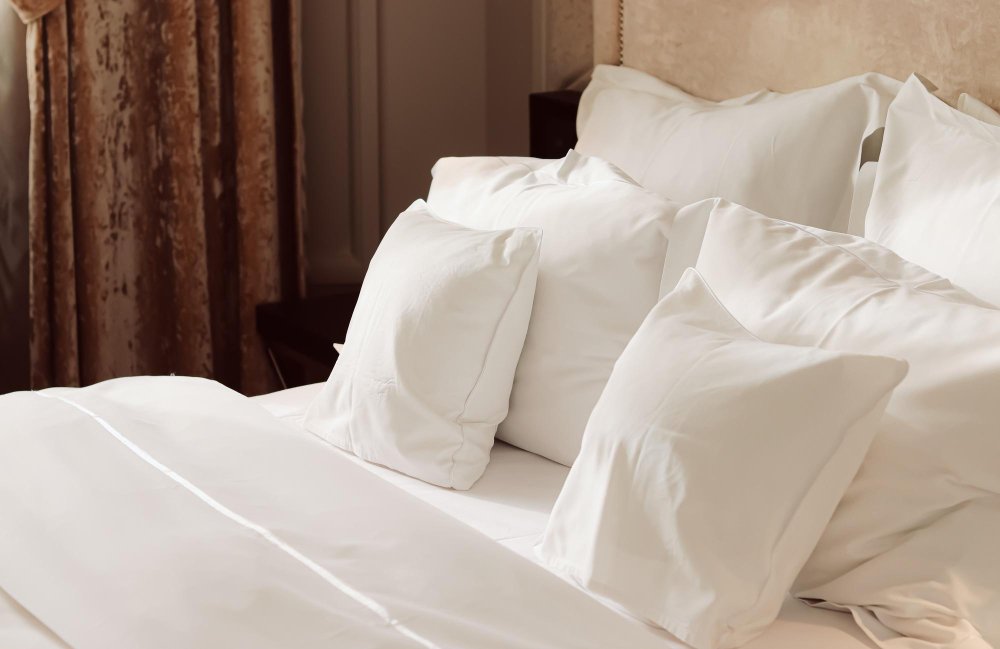
Bedding
This is where mélange linen really shines. The fabric’s breathability helps regulate sleep temperature, while the subtle color variation adds visual interest without being busy. Mélange sheets, duvet covers, and pillowcases create a relaxed, lived-in look that suits both modern minimalist and rustic styles.
The texture evolution we mentioned earlier is especially nice for bedding. After several washes, your sheets develop that cloud-soft feel that makes you want to stay in bed all morning. Unlike crisp cotton that can feel the same wash after wash, linen bedding becomes uniquely yours.
Consider trying stonewashed linen bedding if you want that broken-in softness right away.
Curtains and Window Treatments
Mélange linen makes beautiful drapery. The wide fabric widths (often 235-255 cm) mean you can create curtains with fewer seams. The natural drape creates soft folds that catch light beautifully, and the mixed colors add depth without pattern.
Linen curtains also provide privacy while still filtering natural light. They’re not as opaque as blackout curtains but create a soft, diffused glow during the day.
Upholstery and Cushions
Medium-weight mélange linen works well for throw pillows, cushion covers, and light upholstery like dining chair seats. It’s durable enough to handle daily use but comfortable enough that you’ll actually want to lean against it.
The muted color tones make it easy to mix and match with other patterns and textures. You can combine solid mélange cushions with patterned ones without the space feeling chaotic.
Table Linens
While damask linen is traditional for formal dining, mélange works beautifully for everyday use and casual entertaining. Placemats, napkins, and table runners in mélange linen have a relaxed elegance that suits modern dining styles.
The antibacterial properties mean table linens stay fresher between washes, and the strong fibers can handle frequent laundering without wearing out.
When to Choose Mélange Linen
Mélange weave is ideal when you want:
- Visual interest without bold patterns
- A sophisticated, muted color palette
- Fabrics for transitional or modern interior styles
- Durable textiles that improve with age
- Natural, sustainable home furnishings
Consider other options when you need:
Care and Maintenance
Proper care keeps your mélange linen looking beautiful for years. The good news is that linen is relatively forgiving and actually gets better with washing.
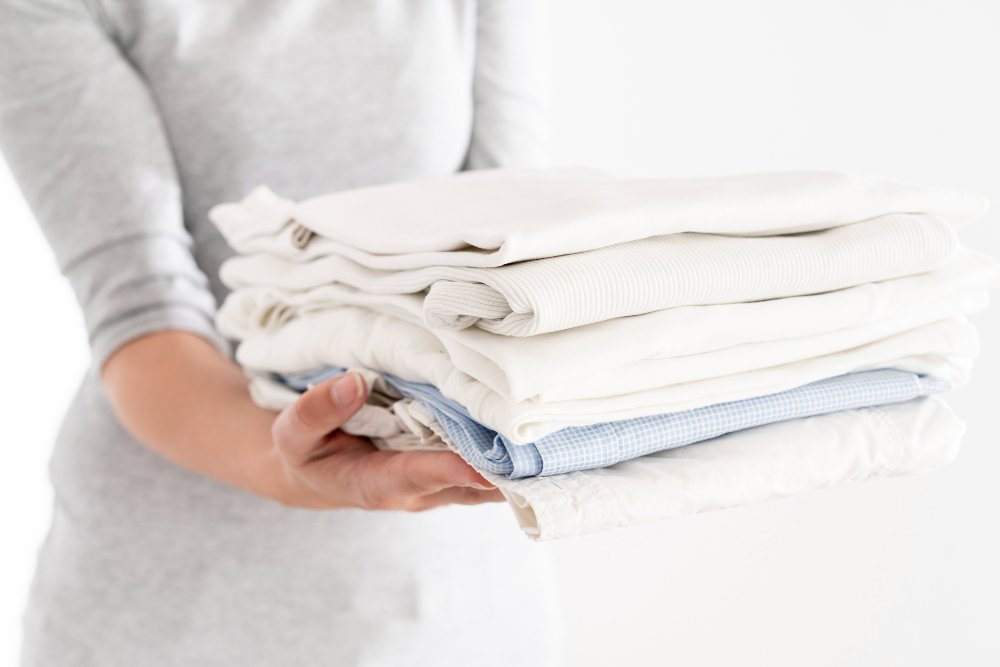
First Wash
Always pre-wash linen before using or sewing. This accomplishes two things: it allows for that initial 5-8% shrinkage, and it begins the softening process. For the first wash:
- Machine wash in warm water (40°C/100°F)
- Use a gentle liquid detergent (avoid powder, which can leave residue in the fibers)
- Don’t overload the washing machine; linen needs room to move
- Skip fabric softener (it coats fibers and reduces absorbency)
Regular Washing
For ongoing care:
- Temperature: Wash in cool to warm water (30-40°C/85-100°F). Linen can handle hot water, but it’s not necessary for cleaning and uses more energy.
- Detergent: Use a mild liquid detergent. Harsh chemicals can weaken fibers over time.
- Cycle: Normal or delicate cycle both work. Heavy-duty cycles are unnecessarily aggressive.
- Colors: Wash similar colors together for the first few washes, though mélange pieces are less likely to bleed than solid-dyed fabrics because the yarns were dyed before weaving.
Drying
You have two good options:
- Line drying: This is gentlest on the fibers and free. Hang linen outside or indoors, smoothing out major wrinkles with your hands. Linen dries quickly.
- Tumble drying: Use low heat and remove items while slightly damp. This creates a relaxed, lived-in look. High heat can weaken fibers over time.
Ironing and Wrinkles
Here’s where opinions differ. Linen wrinkles naturally, and many people (including interior designers) consider this part of its charm. The relaxed, rumpled look is actually trendy in home decor.
If you prefer crisp linen:
- Iron while the fabric is still slightly damp
- Use high heat (linen can handle it)
- A spray bottle helps if you forgot to iron damp fabric
- Iron on the wrong side to protect color
The mélange coloring actually helps disguise wrinkles better than solid colors, so you might find you can relax your ironing standards with these pieces.
Stain Removal
Linen’s smooth fibers resist dirt naturally, but stains happen. Act quickly:
- Blot (don’t rub) fresh stains immediately
- Rinse with cold water from the back of the fabric to push stains out
- For stubborn stains, make a paste of baking soda and water, apply, let sit for 30 minutes, then wash
- Oxygen-based bleach (like OxiClean) works well on white or light linen; avoid chlorine bleach
Use our linen care calculator for personalized washing instructions based on your fabric type and machine settings.
For complete details on maintaining your textiles, read our comprehensive linen care guide.
Sustainability Considerations
Linen is one of the most environmentally friendly textiles you can choose. Here’s why.
Resource-Efficient Growing
Flax requires much less water than cotton. It can grow in poor soil not suitable for food crops, and in some cases, it can actually rehabilitate polluted soil. The plants rarely need pesticides or fertilizers because they’re naturally hardy.
Flax also has a high rate of carbon absorption during growth. The entire plant is usable: fibers become linen, seeds become flaxseed oil or food supplements, and even leftover plant material can be used for paper or animal bedding. There’s virtually no waste.
Production Process
Linen production uses less energy than synthetic fabrics. The retting process relies on natural bacteria and moisture rather than harsh chemicals (when done traditionally). However, water-retting can pollute streams if not managed carefully, so dew-retting is more sustainable.
Look for certifications that indicate sustainable practices:
- GOTS (Global Organic Textile Standard): Ensures organic growing and sustainable processing
- OEKO-TEX: Certifies the fabric is free from harmful chemicals
- Bluesign: Focuses on safe production processes
- European Flax: Indicates European-grown flax with strict environmental standards
Longevity and Waste Reduction
The biggest sustainability factor is durability. Mélange linen pieces can last 20-30 years or more with proper care. Compare this to fast-fashion textiles that might last 1-2 years before pilling, fading, or falling apart.
When linen finally wears out, it’s biodegradable. If you bury untreated linen in soil, it will decompose in a few weeks to months, returning nutrients to the earth. This is very different from synthetic fabrics, which can take hundreds of years to break down and release microplastics.
Made-to-Order Production
Many quality linen producers make items on demand rather than holding large inventories. This reduces waste from unsold stock and allows for customization. You might wait longer for your order, but you’re supporting a more sustainable production model.
Learn more about sustainable textile choices in our natural vs synthetic fabrics guide.
Frequently Asked Questions
Is mélange fabric wrinkle-resistant?
No, mélange linen wrinkles just like all linen fabrics. Linen’s natural stiffness and low elasticity mean it creases easily. However, the mixed colors of mélange weave help disguise wrinkles better than solid colors, so they’re less noticeable. Many people appreciate linen’s relaxed, wrinkled look as part of its natural character. If you prefer crisp fabric, you’ll need to iron mélange linen after washing.
How does mélange linen differ from printed linen?
Mélange linen creates color effects through weaving different colored yarns together. The colors are built into the fabric structure and go all the way through both sides. Printed linen has designs applied to the surface after weaving, so patterns sit on top of the base fabric. Mélange colors tend to be more durable because they’re integral to the yarn, while prints can fade or wear away with washing and use.
Can you bleach mélange linen?
Avoid chlorine bleach, which can weaken fibers and cause uneven discoloration in yarn-dyed fabrics. For white or light mélange pieces, you can use oxygen-based bleach (like OxiClean) if needed for stain removal. Always test in an inconspicuous area first. For most cleaning needs, regular detergent in warm water works fine.
Does mélange linen pill?
Quality linen rarely pills. The long, smooth flax fibers don’t shed or ball up like shorter cotton fibers can. After years of use, you might notice slight surface wear in high-friction areas, but proper pilling shouldn’t occur. If you’re seeing pilling, it might indicate lower-quality linen or a cotton-linen blend.
What thread count should I look for in mélange linen?
Thread count is less meaningful for linen than for cotton. Linen fibers are thicker than cotton, so thread counts are naturally lower (typically 80-150). Instead, focus on fabric weight (measured in grams per square meter). For bedding, 160-200 g/m² is ideal. Heavier isn’t always better; very dense linen loses breathability.
Will mélange linen fade over time?
Like all fabrics, mélange linen can fade slightly with repeated washing and sun exposure. However, because the yarns are dyed before weaving (rather than the fabric being dyed after), the color penetrates more deeply. This makes mélange more fade-resistant than piece-dyed fabrics. To minimize fading, line-dry out of direct sunlight and wash in cool to warm (not hot) water.
Is mélange linen good for people with sensitive skin?
Yes, linen is naturally hypoallergenic. It doesn’t irritate skin and actually has antibacterial properties that help prevent irritation. The smooth flax fibers don’t trap allergens like dust mites the way some fabrics do. For people with sensitive skin or allergies, linen bedding is often recommended. Just make sure to wash new linen before use to remove any processing residues.
Can I use mélange linen for sewing projects?
Absolutely. Mélange linen works beautifully for garments, home decor items, and accessories. Keep in mind that linen can be slippery to cut and has no stretch, so it behaves differently than cotton. Use sharp scissors or a rotary cutter, and consider using weights instead of pins to avoid marking the fabric. Prewash before sewing to account for shrinkage. Check out our fabric cutting guide for tips.
How do I store mélange linen items?
Store clean, completely dry linen in a cool, dry place with good air circulation. Avoid plastic bags, which trap moisture and can lead to mildew. Instead, use cloth bags or simply stack items on shelves. Linen can handle being folded (the wrinkles will come out with use), but if you’re storing table linens, rolling them can help minimize creases. Cedar blocks help deter moths naturally without chemical mothballs.
Final Thoughts
Mélange weave linen brings together traditional textile craftsmanship and modern design sensibility. By weaving together yarns in complementary colors, this fabric creates visual depth and character that solid colors can’t match. The result is versatile enough for both contemporary minimalist spaces and warm, rustic interiors.
Unlike printed fabrics where patterns sit on the surface, or solid-dyed linens that can show wear more obviously, mélange weave has color built into its structure. This makes it particularly durable and forgiving. The subtle color variations help hide wrinkles and wear, while the yarn-dyed construction means the fabric maintains its appearance even after years of washing.
From a practical standpoint, mélange linen offers everything you’d want in home textiles: strength, breathability, natural temperature regulation, and antibacterial properties. It works equally well in summer and winter. The fabric’s tendency to soften with each wash means your investment improves over time rather than degrading.
The environmental benefits add another layer of appeal. Flax grows with minimal water and no pesticides, the production process creates little waste, and the finished fabric can last decades before eventually biodegrading naturally. In a world of fast fashion and disposable goods, mélange linen represents a return to quality and longevity.
Key Takeaways
- Choose mélange linen when: You want sophisticated color depth without bold patterns, need durable fabrics for high-use areas, prefer natural and sustainable materials, or like textiles that improve with age.
- Remember for care: Always pre-wash to allow for shrinkage, use cool to warm water and liquid detergent, embrace the natural wrinkles or iron while damp, and line-dry or use low tumble heat.
- Best uses: Bedding that regulates temperature year-round, curtains that filter light beautifully, upholstery and cushions for modern or rustic spaces, and table linens for casual elegance.
- Quality indicators: Look for European (especially Belgian, Lithuanian, or French) flax, check fabric weight for your intended use (160-200 g/m² for most home textiles), and seek certifications like GOTS or OEKO-TEX for sustainability assurance.
- Common misconceptions: Mélange isn’t the same as jersey (that’s a knit construction), it’s not heather (different mixing method), and it can be made from any fiber, not just linen.
Whether you’re replacing worn-out bedding, updating curtains, or adding texture to your living space, mélange weave linen offers a timeless option that balances beauty with practicality. The initial investment is higher than synthetic alternatives, but the decades-long lifespan and minimal environmental impact make it worthwhile.
Ready to find the perfect linen for your project? Use our linen type selector quiz to get personalized recommendations, or explore our linen care calculator to create custom maintenance instructions for your specific pieces.

